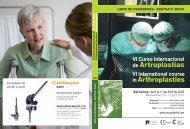cadera / hip - Active Congress.......
cadera / hip - Active Congress.......
cadera / hip - Active Congress.......
Create successful ePaper yourself
Turn your PDF publications into a flip-book with our unique Google optimized e-Paper software.
MIÉRCOLES / WEDNESDAY<br />
116<br />
CAUSE AND PREVENTION<br />
OF NECK FRACTURES IN<br />
HIP RESURFACING<br />
P. Beaulé<br />
Head Adult Reconstruction<br />
Division of Orthopaedic Surgery<br />
University of Ottawa, Canada<br />
The reintroduction of <strong>hip</strong> resurfacing has<br />
been fostered by the introduction of metal<br />
on metal bearing. Early results have been<br />
promising both in the short and medium term,<br />
however although relatively low at 1-2%, the<br />
occurrence of a femoral neck fracture represents<br />
a signifi cant disadvantage to a stem<br />
type total <strong>hip</strong> replacement.<br />
The occurrence of a femoral neck fracture is<br />
multifactorial in its etiology where a certain<br />
threshold of the bony structural integrity must<br />
be reached for it to occur. Some of these factors<br />
include damage to the vascular supply<br />
to the femoral head by surgical approach,<br />
damage to the retinacular vessels, and over<br />
cement penetration leading to thermal necrosis<br />
of the bone.<br />
There are also patient factors such osteoporosis<br />
which may permit over cement<br />
penetration as well as presence of femoral<br />
head cysts. Finally, some guidelines will be<br />
provided to minimize those risks in respect<br />
to femoral component positioning i.e. relative<br />
valgus and choice of surgical exposure i.e.<br />
preserving femoral head vascularity.<br />
RECOMMENDED READING:<br />
ORTHOPEDIC CLINICS OF NORTH AMER-<br />
ICA: APRIL 2005 VOL 36 NO. 2 entitled Surface<br />
Arthroplasty of the Hip Revisited edited<br />
by Leunig and Beaulé.<br />
Notching of the Femoral Neck During Hip<br />
Resurfacing. A vascular study.<br />
PE Beaulé, P Campbell, R Hoke and F. Dorey<br />
JBJS 88B Vol 1, pp 35-39, 2006.<br />
Femoral Head Blood Flow during Hip Resurfacing.<br />
PE Beaulé, P Campbell, Paul Shim<br />
Clin Orthop and Rel Res (E Pub Sept 28<br />
2006)<br />
Vascularity of the Arthritic Femoral Head and<br />
Its Implications for <strong>hip</strong> resurfacing.<br />
PE Beaulé, P Campbell, Z Lu, Ganz K, Beck<br />
M, Leunig M and Ganz R.<br />
JBJS Am Suppl December 2006<br />
SURFACE ARTHROPLASTY<br />
OF THE HIP: RESULTS OF<br />
MULTICENTER TRIALS<br />
V. M Goldberg, M.D<br />
Department of Orthopaedics<br />
Case Western Reserve University<br />
University Hospitals of Cleveland<br />
Cleveland, Ohio, USA<br />
Hip resurfacing arthroplasty using metal on<br />
metal surfaces has become another option<br />
for the young patient with significant <strong>hip</strong><br />
arthritis. Surface replacement arthroplasty<br />
(SRA) provides enhancement to the lifestyle<br />
of young active patients while conserving<br />
bone to make future revisions easier. There<br />
are a number of additional advantages to this<br />
procedure. They include: an increased range<br />
of motion because of the large diameter femoral<br />
head, a more wear resistant couple compared<br />
to traditional surfaces, and a signifi cant<br />
reduction of <strong>hip</strong> dislocation because of the<br />
large femoral head diameter. A large femoral<br />
head approximating normal <strong>hip</strong> anatomy may<br />
provide patients an opportunity for enhanced<br />
kinematics with improved function.<br />
The original designs used in resurfacing <strong>hip</strong><br />
replacements were generally not successful





